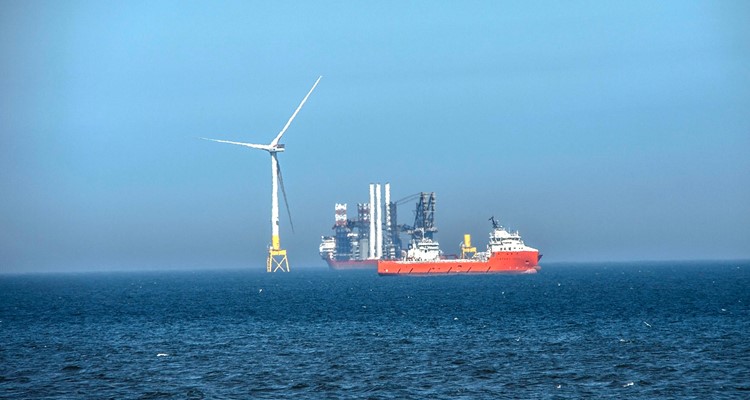Vice President for Survivex and AIS Training, Paul Knowles, provides his view on growth in the wind industry...
Last week (6th July) we launched our suite of GWO Training in Aberdeen. As you can imagine this is a significant strategic step for us and I’ve set out below why I believe the wind is turning in Aberdeen (no apologies for the pun!).
The UK offshore wind sector has been leading the way globally, for the first time in a generation the British engineering sector has been producing the biggest and the best engineering solutions. As of 2019 the UK had 35% of global offshore wind capacity installed, the UK had the first offshore wind turbine off the coast of Northumberland in the year 2000, the first onshore wind farm in Cornwall in 1991 and still has the largest wind farm off the Humberside Coast “Dogger Bank”.
Scotland has of course had a turbulent journey into renewables. Trumps golf course famously put up a massive fight and whilst onshore wind is prevalent in Scotland, it is not as mainstream as in other regions. However, things are changing, the “ScotWind” leasing round from Crown Estate Scotland in 2020 should see the market rise to over 10-12GW by 2030 alongside a raft of recent contract announcements and job predictions in just the last month.
We are all seeing a greater focus on alternate energy solutions, of which Offshore Wind is very prevalent in the conversations I have with our clients and stakeholders. I think whilst Covid-19 has maybe accelerated some peoples plans to protect their revenue streams, I think the reality is that businesses were already manoeuvring to enter the wind market in Scotland. We see PD Ports and MS Group announcing moves into the Wind sector whilst BrewDog works to be carbon neutral by the end of July.
We certainly see growth from enquiries and activity into our Newcastle facility. With Dogger Bank on our doorstep and the activity on the Scottish Borders we used to be well placed, but now with more and more activity out of Nigg and the reported 2,000 jobs in Montrose the requirement for an Aberdeen Centre of Excellence was clear to see.
It makes sense too, at the time of writing Scotland has 915MW of operational offshore wind including the first floating offshore wind farm (Hywind Scotland) as well as a further 4.1GW of consented projects. On of the largest wind projects in the world is the 950MW Moray East project in the Moray Firth and the Kincardine Offshore Wind Farm off the coast of Stonehaven. The numbers forecast for wind in Scotland are immense. 17,000 jobs (for context, in 2018 nearly 50,000 people travelled offshore in Oil & Gas) so the Wind opportunity represents around 1/3 of that. Already wind generates sufficient electricity for 90% of Scotland’s energy consumption.
What are the similarities of Wind to Scotland’s incumbent Oil & Gas sector? In the same way that we see businesses increasing portfolios we know people will too – Wind has a very similar certification structure to OPITO through the Global Wind Organisation (GWO) accreditations which are recognised by 8 of the top 10 global wind turbine manufacturers. We believe that both industry’s will start sharing the same pool of personnel, how will this be managed in the context of various reports from OGUK and OPITO which show a requirement to simply replace natural leavers from the sector.
Why is now the right time to bring GWO Wind courses into Survivex? It was the right decision both short term and medium term – the lockdown phase really enabled our teams to implement GWO into Survivex without the pressures of working around existing courses – there wasn’t just equipment and structures to build, but all the back office systems and processes too. This isn’t something unfamiliar to us, we have a business unit dedicated to supporting organisations globally with the implementation of training into new facilities. The quiet period definitely helped though.
Medium term we could see the demand growing, we knew through feedback from delegates, clients and the awarding bodies that we have built a very successful facility in Newcastle – we have gone over-and-above the standards to ensure we have solutions to clients that also need scenario or equipment specific training. For now we can also see a gap in the market, there are only two other providers of Wind training in Aberdeen and a handful across Scotland, we could see the demand coming down as we found the overspill would travel to our Newcastle facility for their courses.
Aberdeen is well placed for the wind industry, the region is set to host some of the big supply bases whilst the big principals are lining themselves up – we see Total entering an agreement with SSE Renewables to acquire a 51% stake in the Seagreen 1 wind project, whilst BP’s tone in the media follows the same direction of travel.
For people Aberdeen is well placed and we can see transitions funds already being discussed allowing people to cross-train and “de-risk” their position. A business transition fund of £62m was announced by the Scottish Government as recently as June this year.
I for one look forward to seeing the progress Aberdeen and Scotland make into the green recovery.
For me this is part of making the UK great, ensuring the world uses British expertise in overcoming engineering challenges. It’s already happening, we can see our personnel being used for projects in the USA, Germany, Denmark, China and Taiwan. What a success story this could be. Let’s work to achieve something great.
